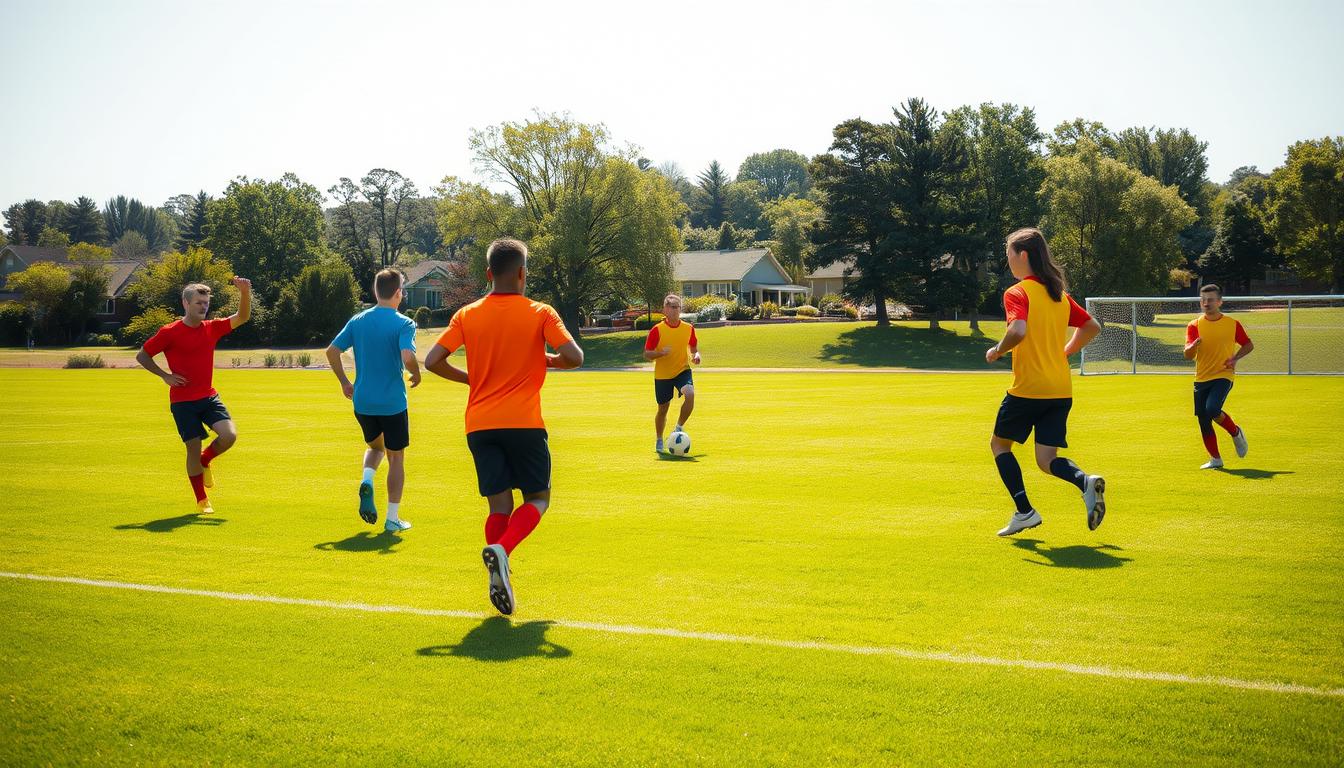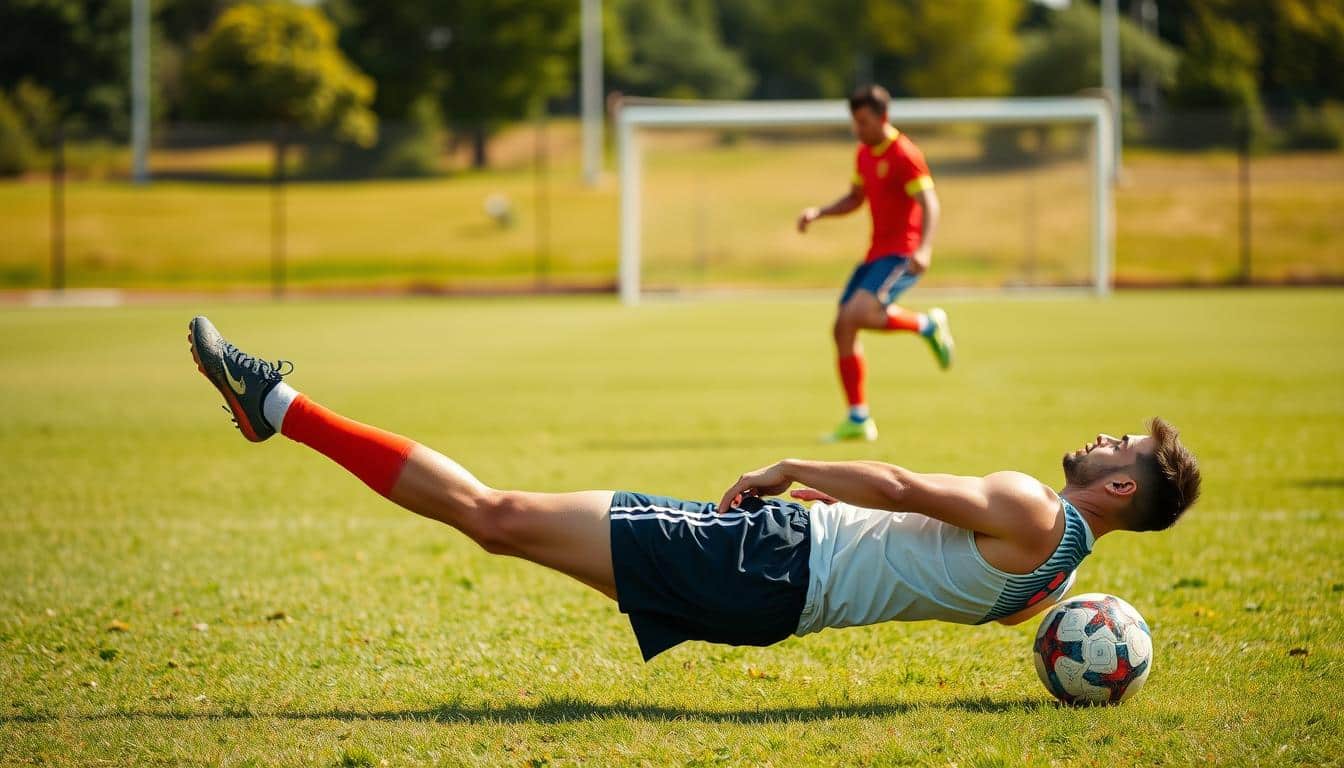Stay Safe on the Field: Soccer Warm-Up Safety Tips

Ever sprinted onto the field without stretching and regretted it later? Proper preparation isn’t just about skill—it’s your shield against injuries. A smart routine primes your muscles, sharpens focus, and keeps you in the game longer. And let’s face it: nobody wants to sit out because of a preventable strain or sprain.
Whether you’re a weekend warrior or a competitive player, warming up correctly matters. Dynamic stretches, light cardio, and sport-specific movements boost blood flow and flexibility. Pair these with mental readiness drills, and you’ll tackle every match with confidence. For parents, fun drills for young players can make safety feel like playtime.
Key Takeaways
- Pre-game routines cut injury risks and improve agility.
- Dynamic movements prepare muscles better than static stretches alone.
- Mental focus is as critical as physical readiness.
- Hydration and gradual intensity increases prevent early fatigue.
- Tailor exercises to mimic in-game actions for maximum benefit.
Soccer warm-up safety tips
Imagine stepping onto the pitch feeling energized, agile, and ready to tackle every challenge. The secret? A dynamic routine that primes your system for action while protecting you from setbacks. Research from FIFA’s training programs shows that gradual intensity progression and sport-specific movements reduce strain risks by up to 30%.
Key Guidelines for Safe Practices
Start with light jogging or side shuffles to elevate your heart rate. These activities boost blood flow without overloading muscles. Follow this with controlled lunges or leg swings—movements that mimic game actions while improving joint mobility.
Focus on activating your core and lower-body muscles through planks or single-leg balances. These stability exercises prepare your body for sudden direction changes. Pair them with arm circles or torso twists to engage upper muscles evenly.
Always prioritize quality over speed. Rushing through drills increases fatigue and compromises form. Finish with short sprints or quick footwork patterns to simulate match intensity safely.
By blending cardio, strength, and flexibility work, you’ll maintain steady muscle activity throughout practice. This approach not only sharpens performance but also builds resilience against common sports-related injuries.
Benefits of a Proper Warm-Up Routine
Ever wondered why some players move effortlessly while others struggle with stiffness? A well-designed routine primes your system for peak action. Johns Hopkins Medicine highlights that dynamic prep work boosts both physical readiness and mental sharpness—key for staying agile during intense moments.
Enhancing Muscle Flexibility
Dynamic stretches like leg swings or torso twists loosen tight areas before exertion. These movements increase blood flow to your muscles, making them more elastic and responsive. Flexible tissues handle sudden sprints or pivots better, reducing strain risks during matches.
Improved mobility also supports your knee joints and lower back. For example, incorporating lateral lunges mimics game-direction changes while stretching hip flexors. This adaptability helps you maintain better control during dribbling or passing drills.
Increasing Injury Prevention
Active prep work cuts the chance of tears or sprains by up to 35%, according to sports research. When your body transitions smoothly from rest to activity, tendons and ligaments handle stress more effectively. Exercises like high knees or heel kicks prepare these areas for explosive actions.
Consistency matters too. Players who warm up before every training session build long-term resilience against common soccer injuries. Pairing these habits with targeted drills sharpens coordination and reaction times—key for avoiding collisions or awkward landings.
Running Drills to Increase Blood Flow
Want to kickstart your system before hitting the field? Targeted running drills activate muscles while improving your body’s readiness for action. These exercises combine controlled motion with timed challenges to boost circulation and sharpen coordination.
Straight-Ahead Running Exercise
Set up five cones 10 yards apart in a straight line. Start at 50% speed for the first two cones, then gradually increase pace. Focus on lifting your knees and landing mid-foot to protect your ankle. Repeat three times, resting 30 seconds between sets.
Hip-Out and Hip-In Drills
Place two markers 5 yards apart sideways. Step laterally with your right leg, rotating your hip outward. Return to center, then step left with an inward rotation. Keep your chest up and maintain side-to-side balance. Perform 8 reps per direction.
Quick Forward & Backward Movements
Mark a 5-yard zone with tape. Sprint forward, then immediately backpedal to your starting point. Stay light on your feet, bending knees slightly for quick direction changes. Time each round—aim to shave half a second off your initial attempts.
These training routines build agility while reducing injury risks. For best results, pair them with dynamic stretches and hydration breaks. Consistent practice enhances your ability to read the field and react under pressure.
Strength and Balance Exercises for Injury Prevention
Building a solid foundation isn’t just about muscle—it’s your secret weapon against setbacks. These routines target your knee and ankle stability while sharpening coordination. Let’s break down two moves that build resilience and keep you in control.

Single-Leg Stance and Ball Control
Stand on one leg with a slight bend in your knee. Hold for 20 seconds, then tap a ball lightly with your opposite foot. Switch sides and repeat 3 times. This drill improves balance while mimicking in-game movements like passing or pivoting.
Squats with Toe Raise
Lower into a squat, keeping your chest up. As you rise, lift both heels off the ground. Do 12 reps. This combo strengthens your quads and calves, reducing risk injury during jumps or sudden stops.
| Exercise | Focus Area | Key Benefit |
|---|---|---|
| Single-Leg Stance | Balance & Core | Boosts stability during direction changes |
| Squats + Toe Raise | Lower Body Strength | Protects joints from impact stress |
Pair these moves 3x weekly for best results. You’ll notice better body control during tackles and sharper reactions under pressure. Remember: steady progress beats rushed repetitions every time.
Dynamic Stretching and Flexibility Routines
Ever notice how top players glide across the field with fluid motions? Dynamic stretching unlocks that smooth movement while guarding against strains. Unlike static holds, these exercises mimic game actions to prep your muscles for explosive moves.
Essential Moves for Lower Body Prep
Start with walking hamstring stretches. Step forward, extend one leg straight, and hinge at the hips. Keep your back flat as you reach toward your toes. Do 8 reps per side. This motion lengthens tight fibers without overstretching.
Next, try hip flexor lunges. Drop into a lunge, then lift your arms overhead. Push your hips forward gently for 2 seconds. Alternate legs for 10 cycles. This combo boosts hip mobility and activates core muscles.
| Stretch Type | Steps | Key Benefits |
|---|---|---|
| Walking Hamstring | Step & hinge forward | Reduces risk of tears during sprints |
| Hip Flexor Lunge | Lunge + arm raise | Protects knee joints during cuts |
Time each stretch to last 3-5 seconds. Short bursts keep your heart rate up while improving range. Pair these activities with light jogging for full-body readiness.
Consistent training with these routines builds adaptable tissue. You’ll handle sudden stops and quick pivots more safely. Remember: proper form beats speed every time.
Plyometric and Change-of-Direction Drills
Unlock explosive power and razor-sharp agility with drills designed for peak performance. These high-energy exercises build lower-body strength while teaching your body to handle rapid directional shifts safely.
Foundation-Building Jumps
Start with box jumps: stand facing a 12-inch platform. Swing your arms forward as you leap upward, landing softly with bent knees. Do 3 sets of 8 reps. This basic move develops vertical power crucial for headers and aerial duels.
Precision Cutting Patterns
Set up 4 cones in a zigzag pattern 5 yards apart. Sprint to the first marker, then plant your outside foot to cut 45 degrees. Stay low during side-to-side movements to maintain balance. Time each round to track progress.
| Drill Type | Key Focus | Progression Tip |
|---|---|---|
| Box Jumps | Vertical Explosion | Increase height by 2″ weekly |
| Zigzag Sprints | Lateral Control | Add ball dribbling at 75% mastery |
Advanced variations like single-leg hops challenge stability while mimicking game motion. Always prioritize controlled landings over speed—rough impacts increase risk injury. Pair these exercises with rest intervals matching real-match recovery times.
Consistent training sharpens your ability to outmaneuver opponents while protecting joints from common injuries. Remember: quality repetitions beat rushed attempts every time.
Expert Tips to Prevent Soccer Injuries
What separates resilient athletes from those sidelined by setbacks? Proactive habits and swift responses to your body’s signals. Orthopedic specialist Dr. David Porter emphasizes: “Ignoring discomfort today can lead to chronic issues tomorrow.”
Monitor Pain and Mobility Changes
Track stiffness or soreness during drills. If your knee feels unstable during pivots or your ankle twinges after landing, pause immediately. Early signs like limited motion range or swelling often hint at deeper issues.
Use a simple 1-10 scale daily:
- 1-3: Mild discomfort (modify activities)
- 4-6: Persistent ache (reduce intensity)
- 7-10: Sharp pain (stop and assess)
Apply R.I.C.E. and Seek Therapy When Needed
For acute strains, follow R.I.C.E. within 48 hours:
| Step | Action | Duration |
|---|---|---|
| Rest | Avoid weight-bearing moves | 24-72 hrs |
| Ice | Apply cold packs | 15 mins hourly |
| Compression | Use elastic bandages | Daytime only |
| Elevation | Raise limb above heart | 2-3 hrs daily |
Persistent issues? Consult a sports therapist for targeted rehab. Strengthening weak side muscles or improving balance often resolves recurring problems.
Wrap Up: Your Path to a Safer Soccer Experience
Stepping onto the field prepared isn’t just about skill—it’s about playing smarter. Combining running drills, strength work, and dynamic stretches primes your body for action while cutting risk of common injuries. Focus on moves that mirror game motion, like lateral shuffles or controlled lunges, to keep joints like knees and ankles resilient.
Consistency is key. Make these activities part of every practice to build long-term strength and agility. Pay attention to how your body responds during exercises—sharp pain means stop, while mild tension suggests adjusting form.
Pair physical prep with mental focus. Visualize plays or set small goals during warm-ups to sharpen in-game decisions. Remember: proper technique beats speed every time. Land softly during jumps, stay low during cuts, and hydrate regularly.
By blending these strategies, you’ll protect your body and elevate your game. Whether you’re coaching young players or pushing your own limits, smart habits create lasting success on and off the pitch.
